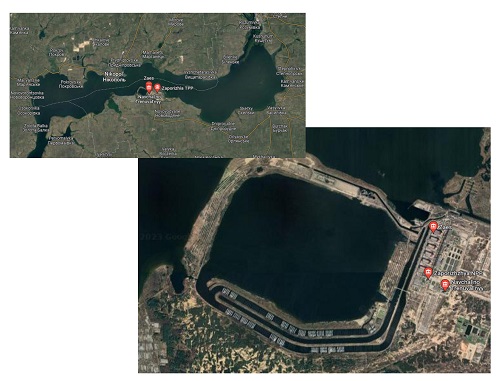Breaching the Nova Khakovka Dam: Update to the May 30, 2023 post on the Zaporizhzhia nuclear power station
Writing on June 6, 2023 – yesterday I (and likely many of you) read that the Nova Khakovka Dam was breached; the Russians say it was a Ukrainian team of saboteurs and the Ukrainians make the same claim about the Russians. For the purpose of this update, who is responsible doesn’t really matter – the possible impact on everyone’s favorite nuclear reactors is the main issue. So here goes….
As I mentioned earlier, nuclear reactors need to keep the cooling water flowing, even months after they were shut down – this is to remove the heat generated when radioactive fission products undergo radioactive decay. What makes this more than an academic point is that the Zaporizhzhia reactors get their cooling water from the reservoir that was backed up behind the Nova Kharkovka Dam. Because this dam was breached, the reservoir is emptying out – the question is whether or not the level will drop to the point at which the reactors will lose their ability to remove this decay heat and, if so, when that will happen. Something else to consider (which I neglected to mention in the earlier piece) is that the site’s emergency diesel generators are also cooled by water from the reservoir and they can’t operate very long without it – without that water, eventually the reactors are likely to suffer thermal damage or even to melt down; the spent fuel, too, albeit it will take longer.

The International Atomic Energy Agency (IAEA) quickly assessed the situation and issued a press statement earlier today (https://www.iaea.org/newscenter/pressreleases/iaea-director-general-statement-to-the-iaea-board-of-governors) noting that the water level in the reservoir is currently dropping at a rate of about 5 cm per hour; the current level is 16.4 m and, at 12.7 m the water will be too low for the pumps to operate. Dividing 370 cm by 5 cm/hr gives us 74 hours – about three days – until the pumps fail.
There would normally be a few options to try to stabilize things; unfortunately, there’s no way to tell at the moment which of these might be feasible. Trying to patch the dam, for example, would slow the flow of water – but since the dam is under Russian control, this would only be possible if the Russians permit it. Similarly, extending the pumps’ suction lines would let them continue drawing water (although they might need booster pumps due to the greater distance and height they’d have to move the water). The reactors’ owner has identified additional sources of cooling water, one of which (the on-site cooling ponds) should be able to keep the reactor cool for a few months)…but even this is a temporary measure. However, since the reactors (including the cooling pond) remain under Russian control, this requires that the Russians actively work to maintain the integrity of the cooling pond and that they permit the modifications required to make use of it.
So at the moment, we know that we have until June 8 or 9; if the reactor operators are permitted to make use of the on-site cooling pond then that’s extended through the end of the summer. Beyond that…at the moment, we just don’t know.